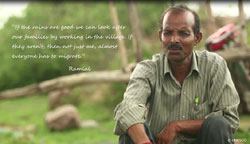Changing Climate, Moving People (UNESCO) by Saransh Sugandh, TV and Film Unit, The Energy and Resources Institute (TERI)
Brussels, September 8, 2015 (UNESCO/SIGNIS) The theme of the cover story of the third issue of SIGNIS MEDIA 2015 is “Reporting Environment” and considers climate change, in the light of Pope Francis’s encyclical Laudato Si “on care for our common home” in which he clarified the moral dilemma inherent in climate change in a way that can unite both religion and humanism. An awareness which can be found in the new film Changing Climate, Moving People made by The Energy and Resource Institute (TERI) and released for the Earth Day 2015 by Unesco.

Changing Climate, Moving People is a 35-minute film, which looks at disaster and climate stress related migration from three different regions in India - Uttarakhand, Bundelkhand and Odisha. These three states are already amongst the leading sources for internal migration and have been hit by extreme weather events like floods (Uttarakhand), drought (Bundelkhand region) and cyclones (Odisha), which are likely to become more recurrent and stronger as a result of climate change. The film is divided in three parts: each part is looking at a specific region and is investigating the nature of migration from this region.
The film`s objective is to increase awareness, engagement and advocacy on the intertwined and complex linkages between moving people and changing climate, and to support the mainstreaming of migration into climate change policies. This has been built on from the policy recommendations of the National Workshop on Migration and Global Environmental Change in India jointly organized by UNESCO and the Government Office for Science, Foresight (GOS), United Kingdom, in Delhi last year.
“People do migrate and will continue to do so in the future. It is primarily the Government`s responsibility to plan for current and future migration and to take into account the impact of climate change on population mobility in India” stressed Mr Shigeru Aoyagi, UNESCO Director and Representative for Bhutan, India, Maldives and Sri Lanka.
The approach of Changing Climate, Moving People is not limited to understanding migration as a demographic process which may be induced by climate change: the film seeks to show how climate change is and will contribute to the multi-causal nature of migration, and establish the triggers behind migrants’ choice to migrate or not to migrate while living in areas affected by environmental change. How do households, communities and individuals decide to migrate? What is the threshold or the build-up of push and pull factors that lead to the decision of migrating? To answer these questions, Changing Climate, Moving People follows the stories of the migrants and their families, to establish the triggers behind their choice to migrate. Avinash Rout, one of the migrants interviewed in the film explains how weather patterns have an impact on his life. “We grow rice and vegetables. Sometimes the crops get damaged by cyclones and floods, at other times by drought. All we grow is just about enough for us. My wife stays with me at home while my children go outside to study and now they are working too. My son sends me 5000 rupees a month.” But not everyone is able to migrate, just like Satti Devi who says “Where can I go? My children are young and there is no one else to look after them”.




Comments powered by CComment